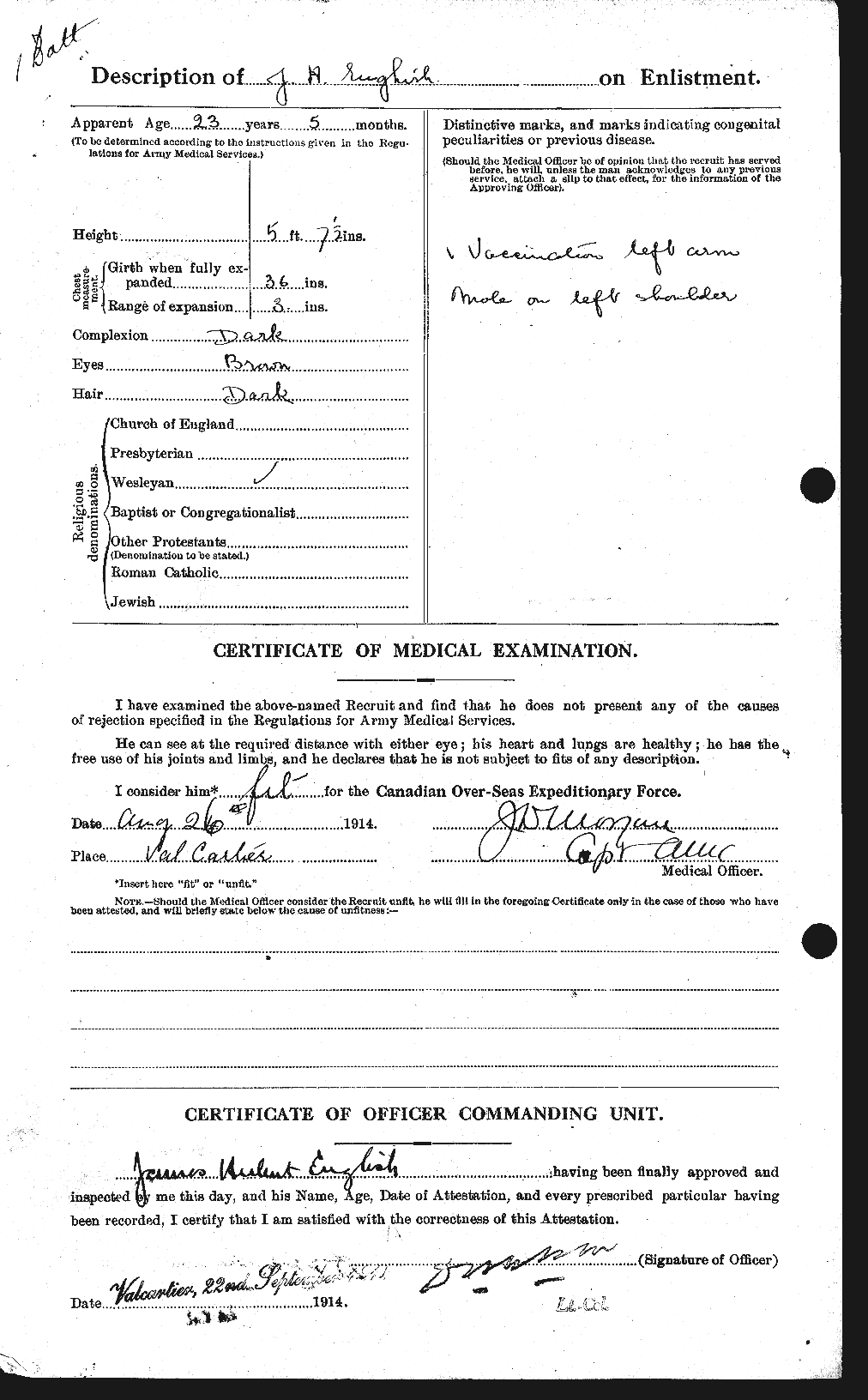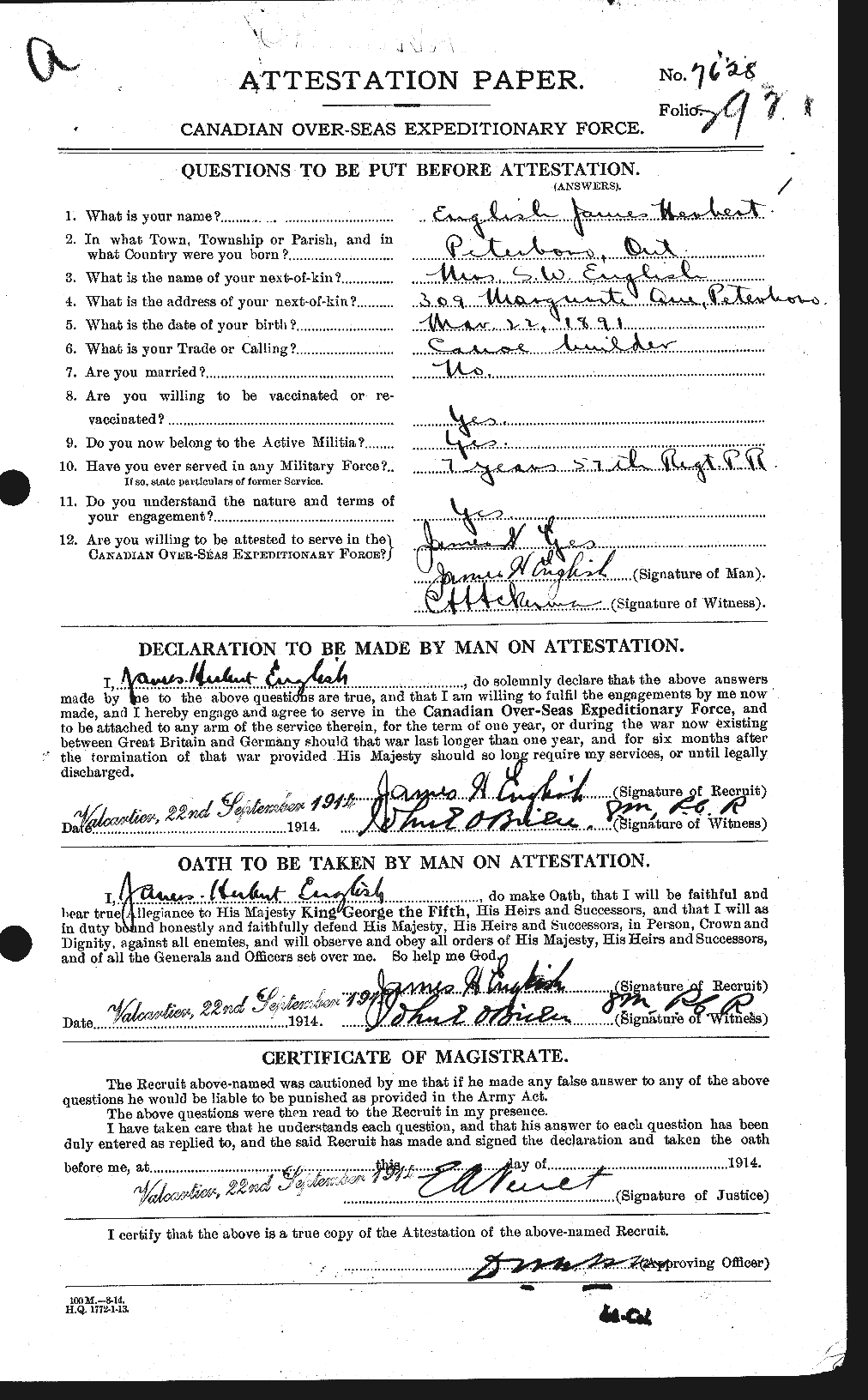

James Herbert English
1891-1915

James Herbert English was born in Peterborough on March 22, 1891. James worked in Peterborough as a canoe builder. He was the son of Mr. and Mrs. S.W English who were both from Peterborough, and he was raised there. His religion was Wesleyan. James was 5-foot 7-and-a-half inches, he had a dark complexion, brown eyes, dark hair, a 30-inch girth when fully expanded, and had a 3 inch range of expansion. Before the war, James had military experience as he previously served 7 years in the 57th Regiment. James enlisted to the World War at the very beginning of the war, on September 22, 1914, at Valcartier. After passing the medical exam, and agreeing to serve in the war for one year or as long as Britain was at war plus six months after, he was cleared on the same day he enlisted. He received one vaccination on his left shoulder. His service number was 7628 and he was assigned to the 2nd Battalion, A Company.
Attestation Papers



The S.S Cassandra brought the soldiers in the 2nd Battalion from Quebec and Gaspe Basin overseas to Plymouth, Britain.
The 2nd Battalion left Quebec City aboard the S.S. Cassandra, and stopped at the Gaspe Basin to pick up more troops. On, October 3rd, they left Gaspe Basin and arrived in Plymouth, Britain, on the 25th, where the Battalion would train for the European battlefields. On February 8th, 1915, his Battalion was mobilized for war. They left England aboard the S.S. Blackwell and arrived in France. The 2nd Battalion’s first battle was in the Second Battle of Ypres, in April 1915. On April 24, 1915 there was a major gas attack near St. Julien. It started around noon, when the enemy attacked from the right side. The battalion managed to repel the enemy, but suffered heavy losses. James Herbert English was killed in action, at the age of 24. He served a total time of 1 year and 7 months in the battalion. The 2nd Battalion had to pull out of the battle on April 29, after suffering many casualties. A total of 6 officers and 68 other ranking men died, James English being one of the 68 men. His body was never found, but his name is featured on the Menin Gate (Ypres) Memorial. His names is on panel 10 - 26 - 28. James was awarded a total of three medals, including: The 1914-15 Star, The British War Medal, and the Victory Medal.
British War Medal

1914-15 Star

Victory Medal



Photo of soldiers on April 22, 1915, the first day the Second Battle of Ypres started. They have cloths around their mouths to protect them from the chlorine gas. This was the first mass use of poisonous gas on the western front., used by Germany.
MENIN GATE (YPRES) MEMORIAL
The Menin Gate Memorial is a large arch that contains the names of 55, 000 British and Commonwealth men whose bodies were never found during the defense of the Ypres Salient, in the First World War. It is located on the eastern side of the town of Ypres (now called Leper), in the Province of West Flanders, in Belgium. It marks one of the starting points to the main road that led allied soldiers to the front line. The memorial was first displayed on July 24, 1927. Following the opening of the arc, every evening at 20:20 under the memorial, the citizens of Ypres sound the “Last Post” to commemorate the fallen soldiers. Since July 2, 1928, this ceremony every day has been uninterrupted. People may also lay a wreath during the ceremony to commemorate the soldiers.
The Menin Gate Memorial located in Ypres

James Herbert English's name engraved in the memorial

2ND BATTALION (East Ontario Regiment)
The second Battalion was an infantry battalion, from the Canadian army. It fought in the First World War, in large battles including Ypres, the Second Battle of Ypres, St. Julien, Festubert, Pozières, Vimy (1917), Arleux, Hill 70, Passchendaele, Amiens, and Canal du Nord. Most of the men in the battalion came from many regions in Ontario, and even some men coming from Quebec City. In August 1914, the local militia gathered at Valcartier to form the battalion. The Battalion left Quebec City to pick up more troops from Gaspe Basin, and then set sail to arrive at Plymouth, Britain. After training, they were sent to the front line in France. Over the course of the battles that the 2nd Battalion was in, by the end of the war it had lost 52 officers and 1,227 other ranks, out of the 242 officers and 5,084 other ranks who had fought with the battalion. Many of the men were killed in action, died from injuries or other causes, or accidentally killed. At Kingston Ontario, at 8:30 in the morning on April 24, 1919, the battalion was officially demobilized.

The distinguishing patch of the 2nd Battalion (Eastern Ontario Regiment)
LIFE IN THE TRENCHES
Living in the trenches was very difficult and non-luxurious. It consisted of mud, rodents and uncomfortable living spaces. soldiers were harassed by rats and lice constantly. Being in the trenches caused fear for most soldiers and lack of sleep left them constantly exhausted. The constant passing of dead or wounded soldiers on stretchers and the loud noises of battle made it almost impossible to relax. There was also a severe worry about getting many sicknesses and diseases. Trench Foot and Trench Fever were very common conditions, which was just another threat to the soldiers health. Trench foot was a painful condition on the feet, caused by long amounts of time immersed in cold water or mud, which would create great pain in their feet. Death was very frequent in the trench life as shells and snipers killed many soldiers, a phenomenon known as "wastage". The "wastage" rate of soldiers was about 10% each month.
Soldiers also had to maintain the trenches, which meant that they had chores to do everyday. They would have to fill sandbags, clean latrines (trench toilets), and repair or lay down duckboards. These chores could be done during the day as they were below ground level and away from the snipers. In the nighttime, the most dangerous and highly skilled chores had to be done. Soldiers would use the shelter of the darkness, and go out into No Man's Land to repair things such as barbed wire, or dig new trenches. During the night time, other tasks could be preformed like gathering intelligence or capturing the enemies troops. On the soldiers off time, they would play games like cards, smoke cigarettes and drink whiskey. Many soldiers would also write in a journal or write letters to send to their loved ones back home.
LETTERS
These are fictional letters created to capture an idea of what letters might have been like during World War 1. One letter is from the perspective of a soldier sent to their family and the other letter is from the perspective of the soldiers mother, sent to the soldier on the western front.
*Click on images to enlarge


Fictional Letter portrayed by James English written to his parents

Fictional Letter portrayed by Mrs. English sent to James English